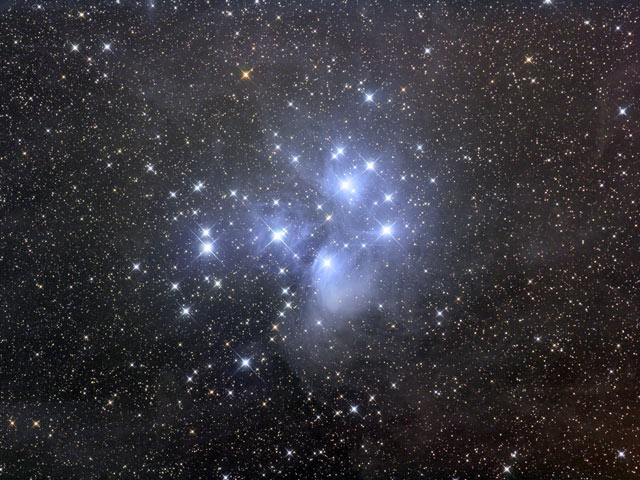
|
Credit & Copyright: Matthew T. Russell
Explanation:
Perhaps the most famous star cluster on the sky, the
Pleiades
can be seen without binoculars from even the depths of a
light-polluted city.
Also known as the Seven Sisters and
M45,
the Pleiades
is one of the brightest and closest
open clusters.
The Pleiades
contains over 3000 stars, is about 400 light years away,
and only 13 light years across.
Quite evident in the
above photograph are the
blue reflection nebulae
that surround the brighter cluster
stars.
Low mass, faint, brown dwarfs have also
been found in
the
Pleiades.
(Editors' note: The prominent
diffraction spikes are caused by the telescope itself
and may be either distracting or provide aesthetic enhancement, depending on your
point of view.)
News: APOD editor to speak in January in New York
|
January February March April May June July August September October November December |
| |||||||||||||||||||||||||||||||||||||||||||||||||||||||
NASA Web Site Statements, Warnings, and Disclaimers
NASA Official: Jay Norris. Specific rights apply.
A service of: LHEA at NASA / GSFC
& Michigan Tech. U.
Based on Astronomy Picture
Of the Day
Publications with keywords: open cluster - stars - pleiades - M 45
Publications with words: open cluster - stars - pleiades - M 45
See also:
- Pleiades from Planet Earth
- APOD: 2025 August 28 Á Galaxies, Stars, and Dust
- APOD: 2025 August 25 Á The Meteor and the Star Cluster
- APOD: 2025 August 7 Á The Double Cluster in Perseus
- APOD: 2025 July 8 Á The Pleiades in Red and Blue
- APOD: 2025 April 28 Á Gum 37 and the Southern Tadpoles
- APOD: 2025 April 8 Á Moon Visits Sister Stars
